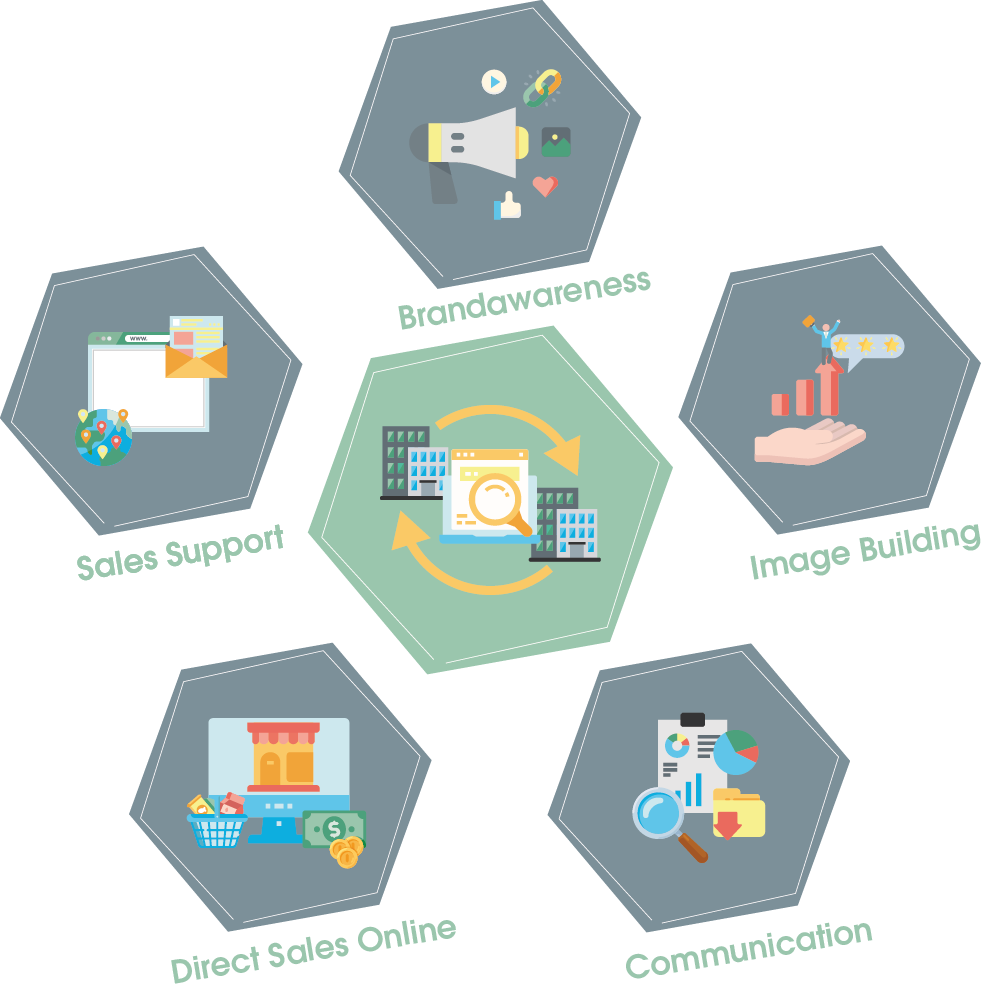
Google Tag Manager is a powerful tool that makes it much easier for website owners to implement and manage tracking codes and marketing tags. In this article you will learn more. ... Continue reading
| 06 min |


| 16 min |
When you think about online marketing, you might first think of marketing measures aimed at B2C customers. However, online marketing measures have long since become part of companies’ strategies there. It is different in B2B marketing: especially online, many companies are lagging behind this requirement and have not really been able to master the entry into the online marketing world or have not even tried. This is fatal, but it is not too late! In the following article, you will learn how B2B companies can secure strategic advantages through search marketing in order to exploit their full potential.
This is what the use of search marketing in b2b brings you
How to find the right strategy and implement it skillfully
Strategically clever: That’s how you reach your goals and exploit potentials
First and foremost, this will address the questions “Why should a B2B company use search marketing? Is it really necessary?”. The answer is “yes”, because search marketing creates competitive advantages! Decision-makers of B2B customers also inform themselves online about offers on the market. More and more are even buying directly on the internet. This was also the conclusion of the study “Online buying behavior in B2B e-commerce 2020” by ibi research at the University of Regensburg, Germany. 68 % of the respondents stated that they usually buy via a website or an online shop. From this follows the simple realization: Only those who are present and visible on the net are considered for this – all others simply fall under the table. It is therefore all the more shocking that around 18 % of the companies surveyed still do not offer their products or service portfolio online. Even more incomprehension arises when one looks at the figures that Statista recently published on B2B e-commerce. Here it becomes clear how important online trade is also in the B2B sector. In Germany, the monthly turnover development in mail-order and internet retailing changed enormously from January 2018 to December 2020. The values of the statistics were always determined on the basis of the same month of the previous year in order to illustrate the differences and the growth. At the beginning of the study in January 2018, sales growth accounted for just 5 %, but already in November 2020, sales increased by over 30 % compared to November of the previous year. With these developments, it is absolutely astonishing that nevertheless so many companies have not yet entered the e-commerce business.


Especially in times of crisis, like the current Corona pandemic, it is a big problem not to be represented or visible online! Social distancing, company closures, home offices, etc. make it more difficult than ever to maintain personal contact. Over-the-counter sales are therefore almost impossible, if not impossible at all, which can result in immense sales losses. In addition, there is a lack of on-site consultations. Most of this currently takes place virtually. But how can customers contact you if they can’t find you? Therefore, relying on search marketing and e-commerce is an absolutely important step in order not to lose your footing in your own industry and the contact to your customers.
The goal of search marketing is not just to rank in Google alone. Sure, that’s an important component, but there are many more channels that are important and can be useful for B2B companies. For example, if you look at Google’s direct competitor Bing, you’ll find a perfect B2B channel. Reason: Many companies work with Windows PCs on which the in-house search engine Bing is installed and preset as the main search engine. That’s why the target group of B2B companies often hangs out here. Fact: Over 97% of B2B inquiries come from the desktop. That’s remarkable!
But search engines aren’t the only important way to use search marketing effectively. Also Social Media platforms (e.g. LinkedIn) are relevant channels to be present and visible to your target audience.
Search marketing includes the following areas
In all four categories, you have the chance to stand out from the crowd of competitors and actively improve your own success. Depending on the measure, they not only increase paid, but likewise organic traffic. The best thing about it is that online marketing measures, unlike in classic marketing, are extremely measurable. This makes it transparent where there is a need for optimization and where there are still a few screws to be tightened in order to get the most out of the individual campaigns. In addition, you will find out quite easily which channels are your perennial favorites. So you can put more work into this to boost your performance.
The B2B environment differs from the B2C business. Primarily, the choice of strategy depends on one’s own goals, capabilities and resources. But there are also constraints and influences that affect not only the decision maker on the customer side, but likewise the selling company itself. Therefore it is important for you to know these and to consider them when developing your strategy. The following influences are meant:
Now that you have illuminated the influences and obstacles, the planning starts. Every strategy development begins with the recording of the current state. Here you determine where you currently stand. This is the basis and helps you to measure how successful your measures were. Important elements of your strategy, which you should pay attention to, are:
Once you have taken a close look at all the elements, you need to define the goals of your strategy so that you don’t lose focus. It is important to make these goals long-term and achievable. Although it can sometimes be good to set high goals for yourself, too high expectations tend to be demotivating because they are rarely achieved. The following five are sensible primary goals of a good search marketing strategy:

Beginning your career in online direct sales is not easy. That’s why it’s all the more important that you set it as your first and most important goal. To achieve this, there are various measures that you can integrate into your strategy. For example, you can evaluate internal data. This will tell you what users are looking for on your site. Is it rather products, item numbers or categories? This information helps you to build your online store according to the customer’s wishes. In addition, it is fundamental that you choose the right store system. Similar to the B2C sector, buyers expect an intuitive shopping experience from companies. However, while in B2C there is a clear focus on product presentation and marketing, in B2B it is primarily a matter of implementing efficient and uncomplicated ordering processes and presenting customer-specific items. In order to hit the bull’s eye with your store system, you should consider various selection criteria:
While not everything is always black or white: while most store systems are designed exclusively for the B2C segment, there are also some very well-known ones that are suitable for both B2C and B2B sales. These include, among others, these well-known store systems:
This doesn’t quite get you started. Good store texts and appropriate, high-quality content are just as important in B2B as in B2C. Only with the right content can you reflect your expert status in your field to customers. You should keep in mind that your target group is often not completely clueless. Potential customers are usually experts in their field themselves. This means that you can in principle assume a higher level of knowledge, and you can assume a higher knowledge base in your content. Therefore, for example, explain the exact functionality and technical features of individual product features and focus on the USPs. The content must offer added value and pick up your target person through sufficiently high quality.
SEO and Paid Ads continue to be measures that push your entry into online direct sales and make it successful. Through both methods, you achieve visibility on the Internet and are found more easily by your target audience. In addition, both are particularly suitable for monitoring and measuring success. This way you can keep an eye on different KPIs and see if your goals are being reached.
The best product, perfectly presented in a good-looking online store, won’t do you any good if no one can find it. To create awareness of your products and brand among potential customers, you can rely on the following measures:
In addition, you should not underestimate social media channels here. The influence of various social platforms is also very large in the B2B sector. They help you to better address your target audience and create brand awareness for your company. Here, similar to content marketing, it’s not purely about spreading your products via social ads and posts. The whole thing is a bit more subtle. Give customers the opportunity to get to know you better. For example, post behind-the-scenes images to make you more approachable. Even corporate buyers are only human. If you manage to build up sympathy via suitable channels such as Twitter, Facebook, LinkedIn and Co. you have therefore already taken a first step towards getting stuck in their heads.
Once you’ve created awareness of your brand, it’s important to map and reinforce your image online. Your website content is an effective tool for this, allowing you to make an impression not only on customers, but likewise on prospects and partners. Informational content that you publish in blogs or magazines, for example, positions you as an expert in the industry and shows your target group that you know what you are doing, regardless of your product or service portfolio. Encyclopedias are also a great way to solidify your expert status. Every industry has technical terms that are fuzzy or unknown to others – and thus to potential customers. If this is the case, the corresponding people will first resort to the classic Google search to inform themselves. If you can now serve these search queries with high-quality content, you have already gained the user’s attention. This perceives you as an expert and comes back to you when he wants to buy your products or services.
But not only the content should be the focus on your website. The usability and user experience of your site should also captivate and convince interested parties. If the user has a positive user experience, it will be remembered – just as much as a negative experience! Corresponding experiences on your website can thus influence the customer’s opinion of your company. Web users are demanding and impatient. One negative event can already lead to the fact that a user has no more confidence in you and your products.
Communication is the name of the game. That’s why it’s important that you exploit the full potential of all communication channels. But where does that even lie? These three methods can help you analyze your potential:
Search marketing, especially SEO, is a powerful tool in the fight for reach and leads. If you are visible on the web, you have competitive advantages over your competition. Local optimizations are therefore an absolute plus. They help you to increase your visibility, especially regionally.
Also email marketing, website personalizations and much more can additionally help you to support offline sales online. The important thing is that you don’t have to do without direct and personal communication. Chats, videos or call to actions make it easy to interact with customers or prospects. In addition, you can provide brochures, catalogs and images online. They help to illustrate your products and services even better. In addition, awards and certificates on your website will ensure that your strengths are highlighted if you place them prominently on your website.
All in all, no matter whether B2B or B2C industry – a visible and findable presence on the Internet is mandatory nowadays. This is the only way to ensure that potential customers can discover you and find out more about you. If you are not displayed in response to a search query for one of your products or services, the customer will click on a SERP snippet of your competitors and possibly buy there.

Get further information about search marketing!